
A Complete Guide To Cybersecurity SEO: How To Rank And Land More Clients
For most cybersecurity companies, the biggest challenge isn’t building great tech, it’s struggling to explain it in a way that resonates with potential buyers.
Complex services, abstract threats, and a rapidly evolving landscape can make it hard for non-technical decision makers to grasp what you offer, let alone why they need it now.
But for B2B cybersecurity, 67% of the buyer’s journey happens online, long before a prospect even talks to sales. And over 90% of these buyers turn to Google, vendor websites, review platforms, and digital content to narrow down their choices.
This is exactly where search engine optimization (SEO) shines. When done right, it helps you show up at every stage of the digital journey, including educating, building trust, and capturing demand before your competitors do.
In this guide, we’ll walk you through what cybersecurity search engine optimization is and some key SEO strategies that your business should be using.
What Is Cybersecurity SEO?
Cybersecurity search engine optimization is all about making your company easier to find on search engines like Google by the right people at the right time. In other words, your website appears in search results when cybersecurity buyers are searching for your services.
It helps cybersecurity vendors, service providers, SaaS platforms, and consultants attract their ideal customers through organic search.
Cybersecurity SEO isn’t like other types of search engine optimization. Cybersecurity SEO comes with its own set of challenges. As we said earlier, you’re selling protection, peace of mind, and technical solutions that most people don’t fully understand.
That means your SEO strategy needs to do more than just get you in the top spot on search engine results pages (SERPs). It needs to:
Speak your audience’s language (think: ransomware protection vs. endpoint detection and response).
Educate without overwhelming.
Build trust fast.
Position yourself as a credible expert in a saturated, high-stakes space.
How Does Google Rank Cybersecurity Websites?
Now that you know what cybersecurity SEO is and the nuances it involves, let’s talk about how Google determines your search engine rankings:
ℹ️ Experience, Expertise, Authoritativeness, and Trustworthiness (E-E-A-T)
E-E-A-T is one of the key frameworks Google uses to evaluate content quality, especially for industries like cybersecurity. Here’s what it means in practice:
Experience: Have you actually worked in the field? Google wants to see that your content is written or reviewed by people with real-world cybersecurity experience. Think practitioner bios, author bylines, or detailed case studies.
Expertise: Are you sharing accurate, technically sound information? Your content should reflect deep industry knowledge about security solutions and more, not just surface-level summaries.
Authoritativeness: Are other websites citing or referencing your work? Backlinks (which we’ll discuss in more detail soon) from trusted tech or security publications, speaking gigs, and media mentions all help you build authority.
Trustworthiness: Is your website secure, up to date, and transparent? HTTPS, clear contact information, policies, and an overall polished site experience help boost trust.
One study of over 40 Google patents and official sources found that there are more than 80 E-E-A-T signals, and you should be prioritizing these if you want to rank.
This cybersecurity firm displays the credentials and industry awards for each of its staff members on its website, potentially intending to boost their E-E-A-T:

ℹ️ Relevance
Google doesn’t just care who you are; it cares about what you’re talking about. If your website rambles on every page about everything from website security solutions to cloud backups and VPN discounts with no clear focus, Google will struggle to understand what you’re actually about.
Instead, you need a tightly themed brand positioning and list individual solutions on their own pages. Choose your lane: Are you the go-to expert on network security? Do you specialize in ransomware protection for schools? Are you a boutique MSSP for fintech startups?
Narrowing your topical focus helps Google see you as a relevant, reliable source rather than a generalist trying to chase every cybersecurity keyword.
ℹ️ Search intent
Search intent is Google’s way of asking what the searcher actually wants when they type in a query. And if your page doesn’t deliver on that intent, it doesn’t matter how many keywords you’ve sprinkled in.
If you serve the wrong kind of content, like a sales pitch on cloud security solutions to someone who just wants a definition, Google will notice. And it’ll likely hurt your rankings in search results in favor of a competitor who nails the match.
ℹ️ Your Money or Your Life (YMYL)
Cybersecurity content often falls into what Google calls Your Money or Your Life (YMYL) pages. These are pages that could impact someone’s financial stability, safety, or well-being.
Google has seriously high standards for YMYL sites. If you recommend cybersecurity tools, offer advice on incident response, or guide companies on compliance, you must meet the search engine’s guidelines.
Just like E-E-A-T, this means:
Accurate, up-to-date information.
Clearly cited sources.
Professional website design.
Qualified authors and visible credentials.
SEO for Cybersecurity: 5 Basics to Get Right
Once you understand how Google ranks cybersecurity websites, you’re ready to optimize your site for SEO.
Below are some basic SEO activities your cybersecurity business needs to get right to rank well:
1. Keyword research: Speak your buyer’s language
Keyword research is where every great SEO strategy begins. And for cybersecurity companies, it’s not just about targeting high-volume terms. It’s about understanding how buyers actually search for solutions, pain points, and trusted providers.
🔎 What is keyword research?
Keyword research is how you identify the words or phrases that your target audience is typing into search engines so you can create content that matches those queries.
But it’s not just about finding the most relevant keywords. It’s also about understanding what people are asking, why they’re asking it, and where they are in the buyer journey.
🔎 The types of keywords cybersecurity companies should target
Let’s explore the categories of target keywords you should prioritize and why they matter:
Informational keywords
These are great for top-of-funnel content and thought leadership. You’re attracting a target audience of people just starting their research journey. Some examples of informational keywords include:
“What is endpoint detection and response?”
“Phishing vs spear phishing”.
“Cybersecurity best practices for remote teams”.
This cybersecurity solution regularly publishes high-quality blog posts targeting informational keywords to target buyers at the start of their journey:
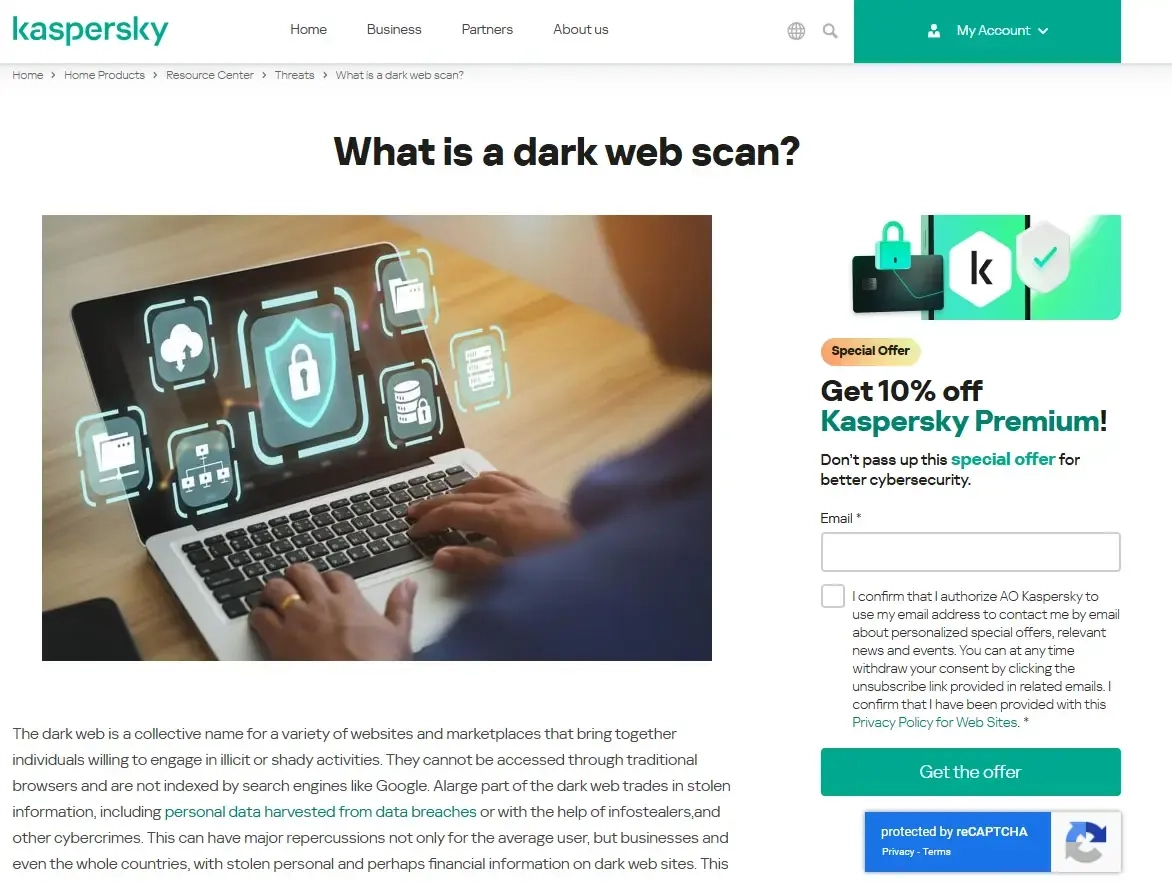
Problem-based keywords
Problem-based keywords zero in on your target audience’s pain points If you can answer them well, you build trust and move users closer to conversion.
Here are some examples:
“How to prevent ransomware attacks”.
“Detecting insider threats”.
“GDPR compliance for SaaS companies”.
On one of its product pages, this cybersecurity firm targets the problem-based keyword “how to detect insider threats”:

Transactional and commercial keywords
These keywords often signal buyer intent. If someone’s searching for these, they’re probably not far from making a purchase. Below are some examples:
“Best MDR providers for SMBs”.
“XDR vs EDR comparison”.
“Penetration testing services pricing”.
🔎 An example of keyword research for the cybersecurity industry
You can use keyword research tools like Ahrefs, SEMrush, or Moz to find the keywords buyers are searching for.
In this section, we’re going to look at an example of keyword research for cybersecurity companies using Ahrefs’ Keyword Explorer. But first, there are two important terms you need to understand:
Search volume (SV): This is the average number of times a keyword is searched for each month.
Keyword difficulty (KD): This is a metric that defines how difficult it would be to rank on page one of Google’s search results for this keyword.
Now, let’s get going with our example. Let’s say you’re a cybersecurity firm that offers cyber awareness training. You could aim to target a broad keyword like “cybersecurity training”. It has good search volume, but it could be very difficult to rank for:
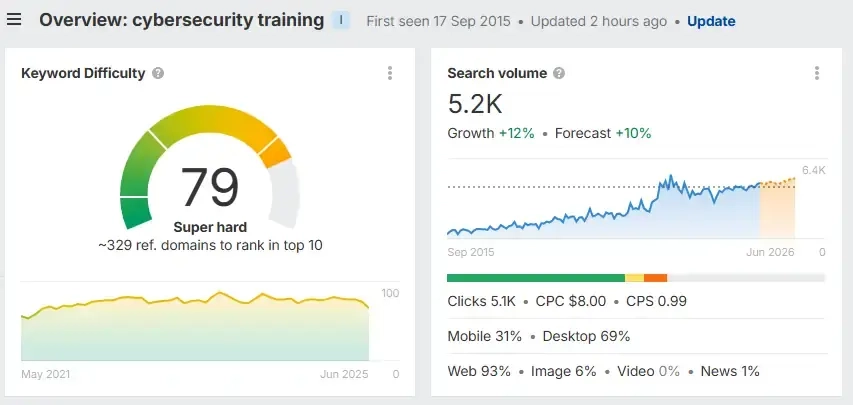
A better option would be more specific and target something like “threat awareness training”. As you can see below, this keyword could be easier to rank for and still has some search volume:

2. Build authority with backlinks
Backlinks are links from other websites that point to yours. When your content is really good, other websites will naturally want to link to it.
When another site links to yours, it’s telling Google that your content is legit. The top-ranking page on Google has 3.8 times more backlinks than those in positions two to 10.
So, the more high-quality backlinks you have, the more credible and authoritative your cybersecurity website appears in the eyes of search engines.
🔗 Why do backlinks matter?
If reputable sites in your industry are linking to you, it’s a strong signal to Google that your content is worth ranking in search results.
For cybersecurity businesses, this can mean:
Climbing the ranks for competitive keywords like “MDR services” or “cloud security for SaaS”.
Being seen as a thought leader.
Getting in front of decision makers who are actively looking for cybersecurity solutions.
🔗 The best link-building tactics for companies that provide cybersecurity services
So, how do you actually get those high-quality backlinks? Here are some of the best link-building tactics that work especially well for cybersecurity brands:
Digital public relations (PR) and thought leadership: Pitch stories, expert quotes, or original insights to tech and business journalists, or use HARO and Qwoted. Cybersecurity is a hot topic, and reporters are always looking for expert commentary on data breaches, new threats, or policy changes.
Guest posts on industry blogs: Contribute thought leadership pieces to reputable cybersecurity and tech publications. Over 65% of cybersecurity buyers say vendor decision-making depends heavily on thought leadership. It’s a great way to get links, build your reputation, and drive targeted organic traffic. Some platforms worth pitching to include Dark Reading, Infosecurity Magazine, TechTarget Security, and Cybersecurity Drive.
Create linkable assets: Develop high-quality content that delivers huge value that others want to link to. This could be data reports, surveys, in-depth guides, toolkits, or templates. B2B blogs earn 97% more backlinks, boosting authority and SEO performance. Think “Top Cyber Threats for 2025”, “Zero Trust Architecture Explained”, or “Incident Response Plan Template”.
Partner with non-competing tech brands: Do you have a partner ecosystem? Co-author content, case studies, or webinars with partners and secure backlinks from their websites in the process. These are highly relevant, natural, and mutually beneficial links.
Leverage vendor listings and directories: Submit your business to trusted cybersecurity directories, comparison sites, and marketplaces. Many of them offer high-authority backlinks. Examples include Capterra or G2, MSSP Alert Vendor Directly, and Crunchbase.
Engage in communities and forums: Contribute to active discussions on platforms like Reddit, Spiceworks, or LinkedIn groups. Links from these platforms can drive traffic and build brand authority.
This cybersecurity brand published a linkable asset in the form of a cyber threats report, which is so valuable that it’s earned 38 backlinks from sites with domain ratings (DRs) of as high as 81:
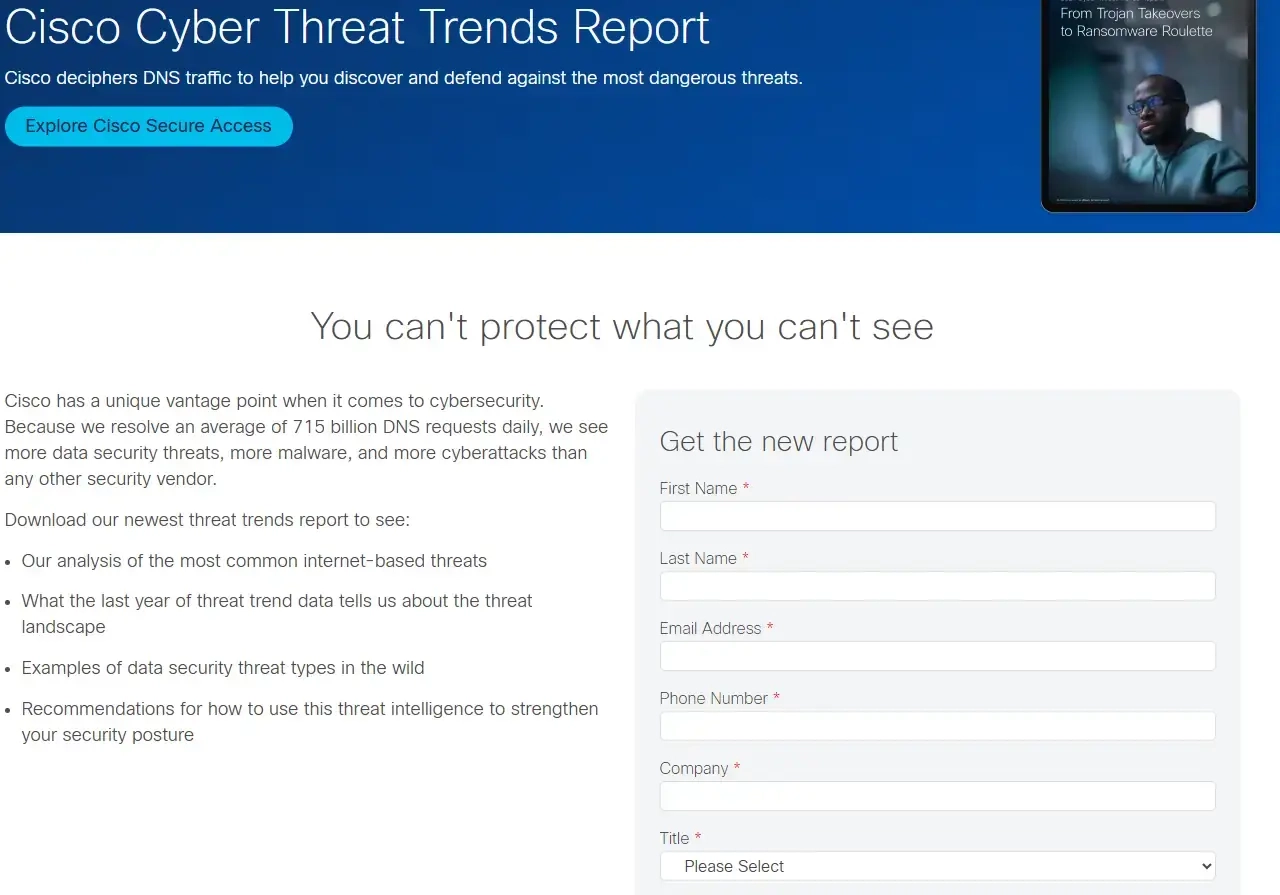
3. On-page SEO: Tweaks that Google and users love
On-page SEO is all about optimizing the stuff on your website, like the words you use, your structure, and images that help Google understand your content and users enjoy it.
Here are a few high-impact on-page SEO areas you’ll want to get right:
➡️ Title tags and meta descriptions
Title tags and meta descriptions are the snippets users see in Google’s search results. They’re often your first impression, so they need to be clear and compelling.
Title tags should be unique for each page, include your primary keyword, and stay under 60 characters so that they don’t get cut off in search results.
Meta descriptions should be under 155 characters, highlight a benefit or unique selling point (USP), and include a mini call-to-action (CTA). According to research that analyzed five million Google results, having meta descriptions results in a 5.8% average increase in clicks.
Below is a good example of a title tag and meta description that are compelling and keyword-rich:

➡️ Image SEO
Cybersecurity sites often rely on visuals like architecture diagrams, dashboards, and infographics. But if you’re not optimizing those images for SEO, you’re missing out on a chance to boost your visibility and accessibility.
You should use descriptive file names to describe what’s in the image, like “zero-trust-diagram.png” instead of “image1234.png”.
Also, adding alt text to your images is super important because it helps Google understand the image and improves accessibility for visually impaired users. Instead of alt="picture1", rather use something like alt="Dashboard showing real-time threat detection alerts in XYZ cybersecurity platform".
➡️ Solutions pages
Too many cybersecurity websites lump all their offerings into one generic Services page and then wonder why they’re not ranking.
The solution to this is to have dedicated solutions pages on your website. Each service or product should have its own optimized page with:
A clear H1 heading that matches what users are searching for.
Keyword-rich subheadings.
Benefits-focused copy, not just tech specs.
Internal links to relevant case studies, blog posts, and CTAs. Case studies are important because 59% of cybersecurity buyers say they play a role in vendor selection.
This cybersecurity business has dedicated pages to each of its solutions, which include compelling copy, case studies, and clear CTAs:
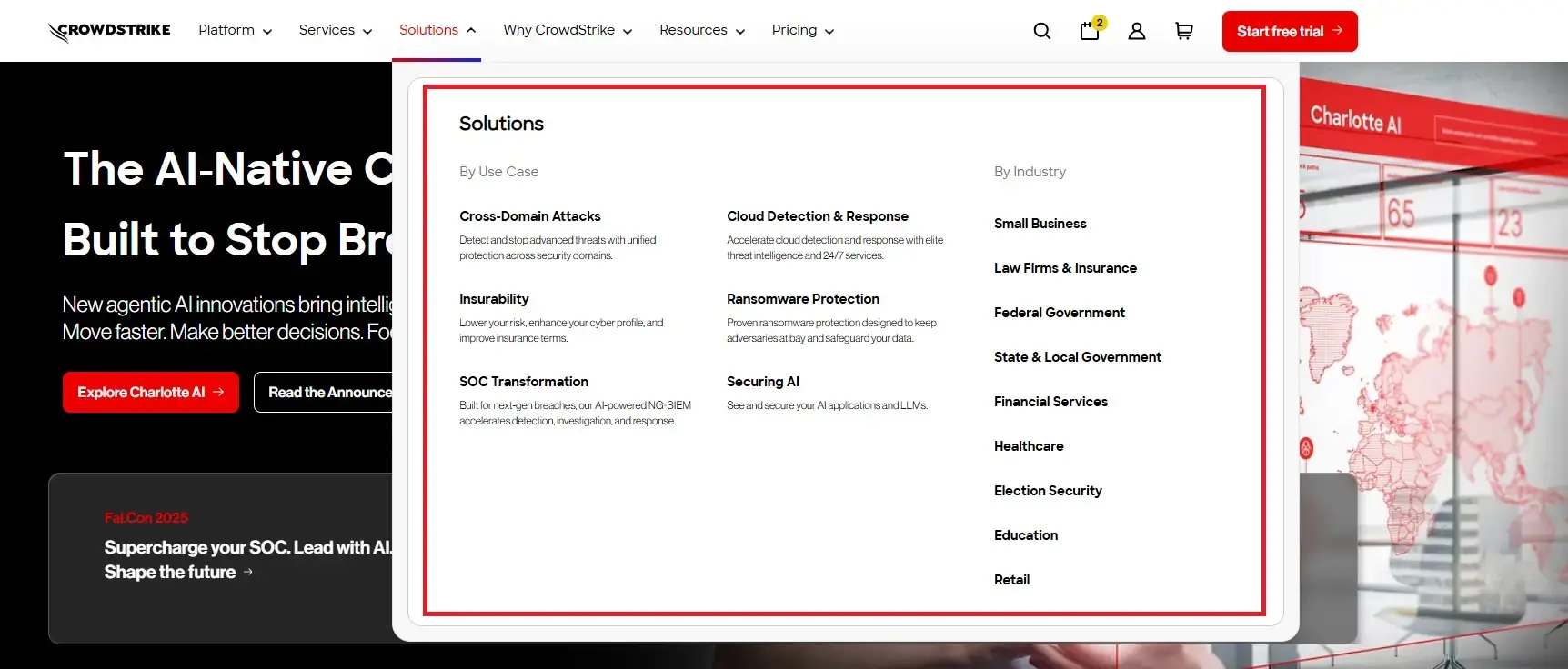
4. Technical SEO: The unseen fixes that make a big difference
Technical SEO focuses on how well your website is built, from crawlability and speed to structure and usability. It’s what helps Google access, understand, and trust your content.
For cybersecurity companies, technical SEO isn’t optional. You’re in an industry where speed, precision, user experience, and professionalism matter. So, a slow, clunky, or error-ridden website doesn’t just hurt your rankings; it impacts your credibility in the industry.
Let’s look at three key technical SEO essentials you’ll want to get right:
⚙️ Mobile-friendliness
More than 93% of internet users access the web using a mobile device, and Google uses mobile-first indexing. This means the search engine primarily evaluates your site based on how it performs on mobile, and mobile-first sites are likely to rank higher.
To make sure your website is mobile-friendly:
Use responsive design so that your layout automatically adapts to different screen sizes.
Make sure buttons and navigation are easy to tap.
Keep text legible without the need to zoom.
Avoid mobile pop-ups that block content.
⚙️ Page speed
In cybersecurity, every second counts. The same goes for your website speed. 70% of consumers say that page speed impacts their purchasing decisions. Slow-loading pages frustrate users and signal a poor experience to Google.
You can speed things up by:
Compressing images without losing quality.
Minifying code like HTML, CSS, and JavaScript.
Enabling browser caching.
Eliminating render-blocking scripts.
⚙️ Schema markup
Schema markup is a type of structured data that helps search engines understand what your content means, not just what it says. Over 72% of pages on the first page of Google use schema, indicating how important it is.
By adding schema to your pages, you can have your website appear in rich results with additional things like star ratings, FAQs, and product information directly in search listings.
This can increase your click-through rate and give your cybersecurity content more visual real estate in the SERPs.
The presence of rich results in the example below suggests that the cybersecurity brand is using schema markup on their website:
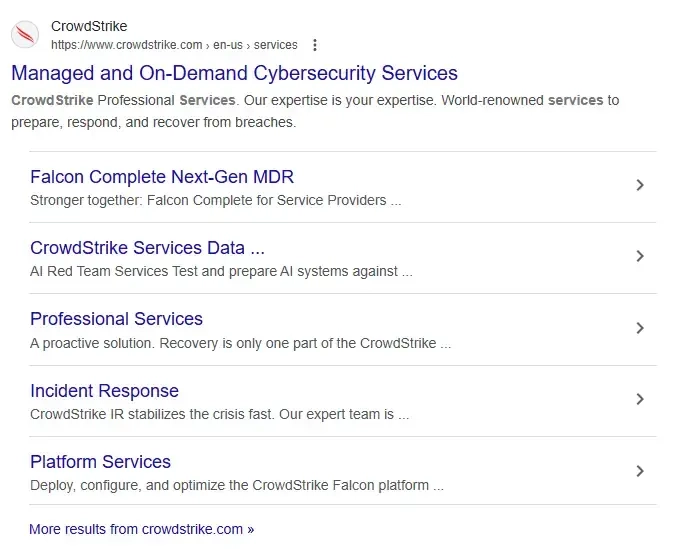
5. Tracking your SEO performance
So, you’ve published high-quality content, built some authoritative backlinks, and made your site technically sound. This is great work, but how do you know if your SEO efforts are actually paying off? That’s where tracking your performance comes in.
Google offers two powerful (and free) tools that cover most of what you need to track your performance: Google Analytics and Google Search Console. Let’s break down what each tool brings to the table:
📈 What you can track with Google Analytics
Organic traffic: Track the number of users landing on your site via organic search and how that number changes over time.
Top-performing pages: Identify which blog posts, service pages, or guides are driving the most visits.
User behavior: Track bounce rates, time on page, and pages per session to understand how users engage with your content.
Conversion tracking: Set up goals like form submissions or demo requests to see how well your organic traffic is converting.
📈 What you can track with Google Search Console
Search queries: See the keywords people are using to find your pages.
Average position: Track how your rankings change over time for key terms.
Click-through rate (CTR): Understand which pages are getting seen but not clicked.
The Best Backlinks to Build Authority for Cybersecurity Companies
In cybersecurity, trust is everything. That trust starts with airtight technology and how your brand appears online.
Earning high-quality backlinks from respected, relevant sources is one of the fastest ways to build authority and boost your SEO in a space where credibility isn’t optional.
There are many ways to grow your backlink profile, from digital PR and guest posts to industry directories and data-driven content.
If you’re ready to ramp up your SEO efforts and earn links that make an impact on your authority, LinkBuilder can help.
We craft backlink campaigns tailored to your industry, audience, and growth goals. Contact us today, and let’s build your authority the right way.

